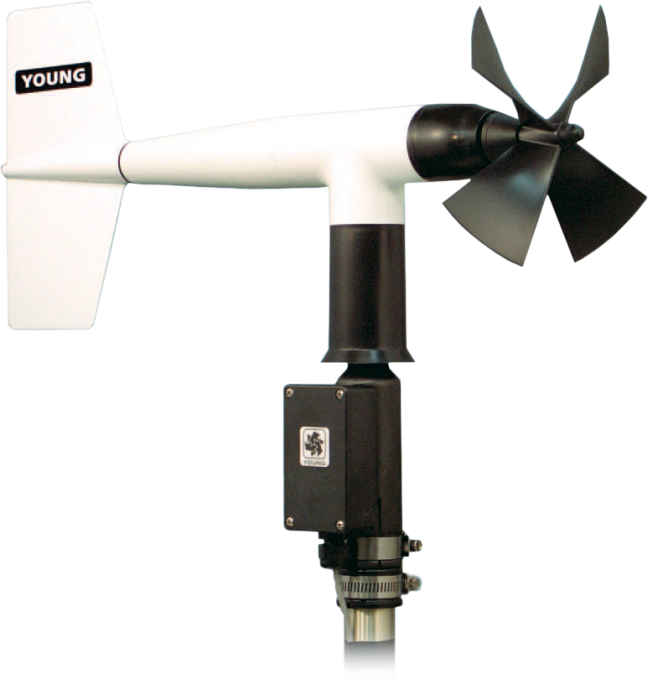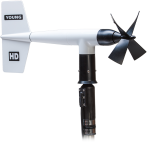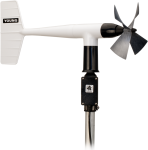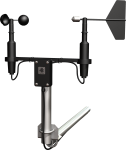
适用于Campbell Scientific大部分的数据采集器






概览
05103 风速风向传感器重量轻,坚固耐用,可在恶劣环境下进行风速风向的测量。设计简单,耐腐蚀,适用于大范围的测量应用。制造厂商为R.M.Young,通过线缆连接Campbell Scientific的数据采集器。
优势与特点
- Rugged enough for harsh environments
- Compatible with the CWS900-series interfaces, allowing it to be used in a wireless sensor network
- Constructed with thermoplastic material that resists corrosion from sea-air environments and atmospheric pollutants
- Uses stainless-steel, precision-grade ball bearings for the propeller shaft and vertical shaft bearings
- Ideal for wind profile studies
- Compatible with the LLAC4 4-channel Low-Level AC-Conversion Module, which increases the number of anemometers one data logger can measure
图像



技术说明
05103 采用耐用的紫外线稳定的热塑塑料,不锈钢和阳极电镀铝材质。耐热塑料可抗击海洋空气环境的侵蚀,抵抗大气污染。精密级别的不锈钢滚珠轴承用于旋桨轴承和立式轴承。
05103 用旋桨测量风速。旋桨转动产生与风速成正比的频率的交流正弦波。传感器线圈中感应的交流信号由安装在传动轴六极磁铁生成。线圈固定在不能旋转的主安装组件的中部,省去了滑环和电刷。
连接在内部电位计上的机身状的传感器被用来感应风向。数据采集器将已知的精确的激发电压传向电位计元件。输出的模拟电压信号与方位角成正比。
产品规格
| Applications | Harsh (Rain with light snow. Little or no riming. Some blowing sand. No salt spray.) |
| Sensor | Helicoid-shaped, 4-blade propeller and fuselage-shaped sensor body |
| Measurement Description | Wind speed and direction |
| Operating Temperature Range | -50° to +50°C (assuming non-riming conditions) |
| Mounting Pipe Description |
|
| Compliance with Standards |
|
| Housing Diameter | 5 cm (2.0 in.) |
| Propeller Diameter | 18 cm (7.1 in.) |
| Height | 37 cm (14.6 in.) |
| Length | 55 cm (21.7 in.) |
| Weight | 1.5 kg (3.2 lb) |
Wind Speed |
|
| Range | 0 to 100 m/s (0 to 224 mph) |
| Accuracy | ±0.3 m/s (±0.6 mph) or 1% of reading |
| Starting Threshold | 1.0 m/s (2.2 mph) |
| Distance Constant | 2.7 m (8.9 ft) 63% recovery |
| Output |
ac voltage (three pulses per revolution) 90 Hz (1800 rpm) = 8.8 m/s (19.7 mph) |
| Resolution | (0.0980 m s-1) / (scan rate in seconds) or (0.2192 mph) / (scan rate in seconds) |
Wind Direction |
|
| Mechanical Range | 0 to 360° |
| Electrical Range | 355° (5° open) |
| Accuracy | ±3° |
| Starting Threshold | 1.1 m/s (2.4 mph) at 10° displacement |
| Distance Constant | 1.3 m (4.3 ft) 50% recovery |
| Damping Ratio | 0.3 |
| Damped Natural Wavelength | 7.4 m (24.3 ft) |
| Undamped Natural Wavelength | 7.2 m (23.6 ft) |
| Output |
|
| Voltage | Power switched excitation voltage supplied by data logger |
兼容性
Mounting
The 05103 can be attached to a CM202, CM202SS, CM203, CM204, CM204SS, or CM206 crossarm via a 17953 Nu-Rail fitting or CM220 Right-Angle Mounting Kit. Alternatively, the 05103 can be attached to the top of our stainless-steel tripods via the CM216 Sensor Mounting Kit. Please note that a lightning rod cannot be used when the CM216 attaches a 05103 atop the tripod’s mast. Therefore the CM216 is only recommended for mounting these sensors if the deployment is short term.
Wind Profile Studies
Wind profile studies measure many wind sensors. For these applications, the LLAC4 4-Channel Low Level AC Conversion Module can be used to increase the number of Wind Monitors measured by one data logger. The LLAC4 allows data logger control ports to read the wind speed sensor’s ac signals instead of using pulse channels. Data loggers compatible with the LLAC4 are the CR200(X) series (ac signal ≤1 kHz only), CR800, CR850, CR1000, CR3000, and CR5000.
Data Logger Considerations
The 05103's propeller uses one pulse count channel on the data logger. Its wind vane requires one single-ended channel and access to an excitation channel (the excitation channel can be shared with other high impedance sensors).
Programming
The 05103's propeller is measured by the PulseCount Instruction in CRBasic and by Instruction 3 (Pulse Count) in Edlog. The wind vane is measured by the BrHalf Instruction in CRBasic and by Instruction 4 (Excite-Delay-SE) in Edlog. The measurements are typically processed for output with the Wind Vector instruction (not present in the CR500 or CR9000 but is present in the CR9000X).
视频与教程
常见问题解答
05103-L: 9
展开全部收起全部
-
This depends on what is broken. Typically, Campbell Scientific can repair the unit, and the user does not have to purchase a new one.
-
The measurement instructions will likely remain the same. However, in addition to the multiplier and offset, the type of pulse may change for the wind speed, and the excitation voltage may change for the wind direction. For an explanation of how the data logger needs to be programmed, see the instruction manual.
-
The short answer is less than 0.01 mA. The wind speed signal requires no power. The wind direction portion of the sensor only uses a maximum of 0.5 mA when excited with 5 Vdc, and then it is only on for 0.016 s for every measurement. When the wind direction is measured every second (typical), the average current drain is less than 0.01 mA.
-
Yes, but this is not a standard product that Campbell Scientific offers. We can, however, order one from the manufacturer (R. M. Young).
-
Orientation of the wind monitor is done after the data logger has been programmed, and the location of True North has been determined. True North is usually found by reading a magnetic compass and applying the correction for magnetic declination, where magnetic declination is the number of degrees between True North and Magnetic North. Magnetic declination for a specific site can be obtained from a USFA map, local airport, or through a computer service.
-
R. M. Young, the manufacturer of this sensor, recommends a maximum cable length of 300 m (984.25 ft) between the wind monitor and a data system/display. For longer cable runs, either the Line Driver (4 to 20 mA outputs) or the Serial Interface (RS-485) is suggested.
-
- Using Short Cut, click the applicable wind direction sensor in the Selected Sensors list of the Outputs screen.
- The two output options enabled are Sample and WindVector. Select WindVector.
- The WindVector instruction has output options. Select an option with mean wind direction in it.
案例研究
Overview As part of the United Nations Development Programme's (UNDP) Climate Adaptation Water and Energy Programme......阅读更多
Agrivoltaics or dual-use solar is a system combining an agricultural crop (viticulture, arboriculture, field crops,......阅读更多
The Problem—When is it safe to spray? Crop dusting is regulated in the province of Alberta......阅读更多
Networks using the ALERT protocol are designed to give immediate access to data that indicates......阅读更多
In 1922, when the intact tomb of Tutankhamen was discovered in Egypt's Valley of the......阅读更多











